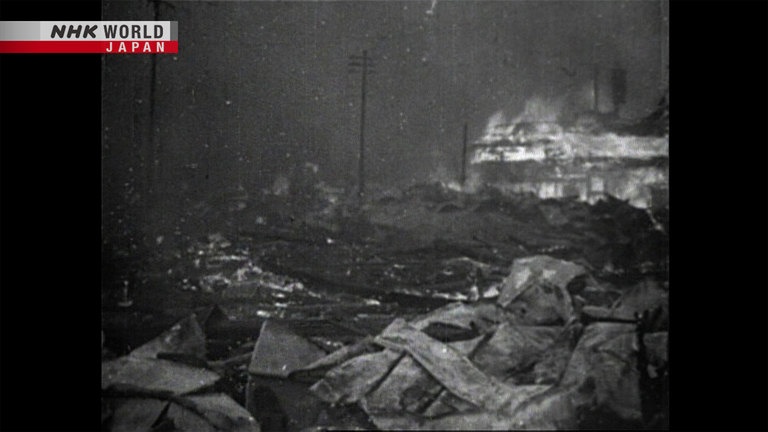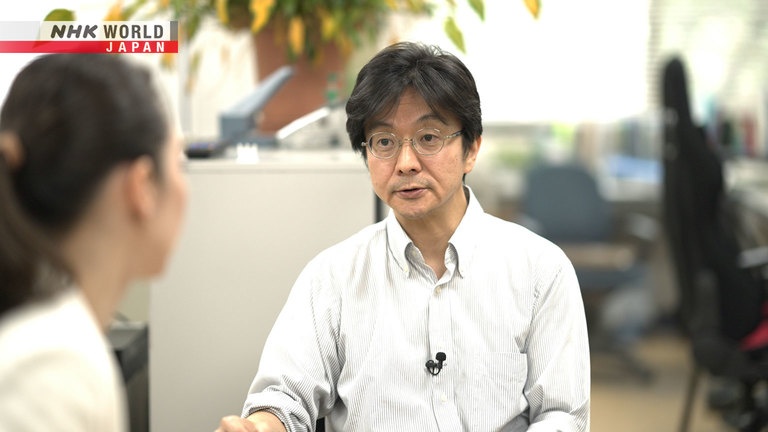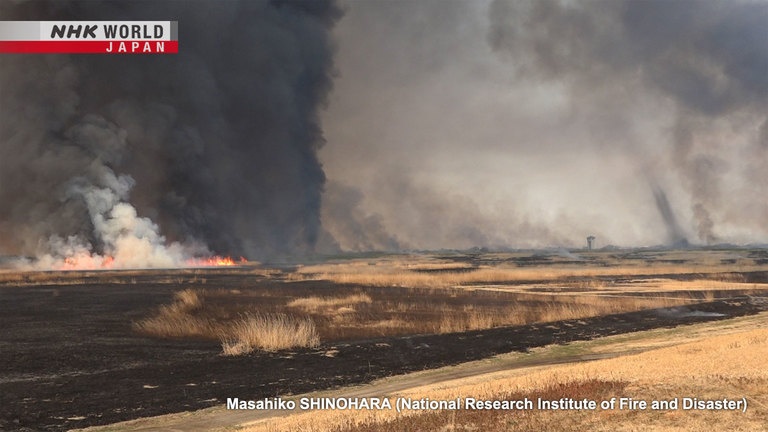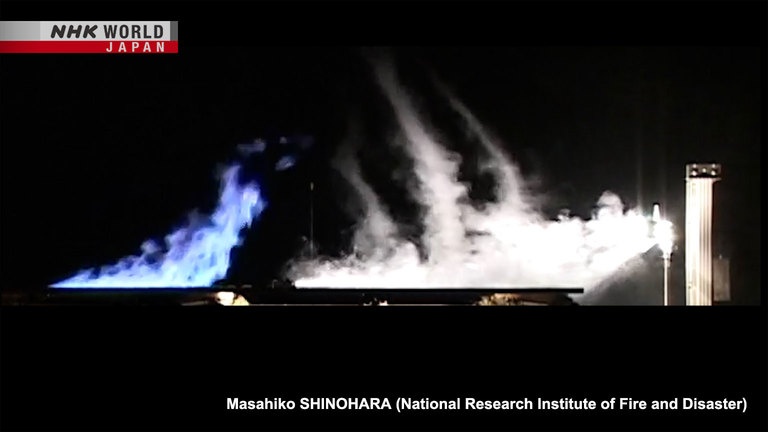#30 Fire Tornadoes
The Great Kanto Earthquake of 1923 was one of the worst disasters in Japanese history. A magnitude 7.9 earthquake centered in the western part of Kanagawa Prefecture caused buildings to collapse, landslides to occur, and a tsunami to hit the coastal areas. However, most of the victims did not die in these disasters; the main cause of death was fire. In one open space in Tokyo, almost all of the nearly 40,000 evacuees who had gathered there died in a fire. Yet this was not just any fire, but rather a fire whirl, or what is more commonly known as a "fire tornado."




Transcript
Japan has a long history of natural disaster.
Now, the power of science is helping to overcome them.
BOSAI: Science that Can Save Your Life.
100 years ago, at 11:58 am on September 1st, 1923, an earthquake of magnitude 7.9 struck Japan.
The epicenter was in western Kanagawa Prefecture.
Kanagawa was hit by violent tremors, many buildings collapsed, and landslides also occurred.
In neighboring Shizuoka Prefecture, a tsunami with a maximum height of 12 meters hit coastal cities directly,
claiming many lives.
In Tokyo and Kanagawa, fires caused particularly severe damage.
About 90% of the estimated 105,000 dead and missing died in fires.
This disaster, which was later called the Great Kanto Earthquake,
was one of the worst in Japan's history.
Earthquakes can have a wide range of damaging effects,
including collapse of buildings, destructive tsunami, and landslides.
In today's program, we'll investigate the latest research on earthquake fires,
and how to protect ourselves from their dangers.
There is a place in Ryogoku, Tokyo, where the reality of the earthquake and fires of 100 years ago is still preserved.
The Great Kanto Earthquake Memorial Museum houses the documents and items related to the quake.
I asked Morita Yusuke, a curator at the museum, to help me understand the scale of the damage.
At first glance, you might not know
what it is, but look closer.
I think it's a rock.
If you look here, you can see some nails.
A box of nails, possibly from a factory,
became so hot that the nails fused into the rock.
There are various remnants from the disaster that can help us understand
why fires caused by the earthquake became so intense and spread so rapidly.
This is a map which shows the movement of the fires in Tokyo City.
The pink areas show the places damaged by fires at that time.
It records where the fires started and how they spread.
There are lots of red circles
which show where the fires started.
Fires started in 134 places in Tokyo.
They broke out in multiple places at the same time,
and spread over a wide area.
The red arrows show the directions in which the fires spread.
We can see that fires started all over the city, and then spread in all directions.
On the day of the earthquake,
very strong winds were blowing,
causing the fires to spread rapidly.
A typhoon was also moving along the northern coast of Japan that day,
which brought strong winds to the Kanto region.
Based on records from the time, we will recreate how the fires spread.
The fires were small in the immediate aftermath of the earthquake,
but after three hours, fanned by strong winds, they had become widespread.
To escape the fire, people began to evacuate with as many of their possessions as they could.
One reason the fires spread was because
people with luggage blocked the roads,
making it difficult for firefighters
to get to the scene.
Open spaces all over the city were filled with evacuees.
One such space was in a particularly dangerous situation.
40,000 people fled to the open space in Ryogoku,
meaning there was only about 1.7 square meters of space per person.
In this overcrowded situation, with fires raging on the opposite bank of the Sumida River,
fires closed in from the north, east, and south at the same time.
People had brought lots of flammable items.
Their possessions caught fire,
and many people died.
There was no way to escape, and more than 38,000 people died.
But it wasn't simply the fires that caused such a catastrophe.
A certain phenomenon caused the fires to become more intense and to spread more rapidly.
In addition to the fires,
fire tornadoes also occurred,
causing many people to lose their lives.
A fire tornado, also known as a fire whirl, is a whirlwind-like vortex
that is generated by a strong updraft, created when air is heated by the fire.
There are a few survivors who witnessed the fire tornado in Ryogoku.
Ichikawa Fumiko was seven years old at the time.
It suddenly became dark,
and black smoke came like this into the open space.
This is a drawing of the fire tornado based on the testimony of those who survived.
It depicts a whirlwind of fire and smoke, blowing away people and their belongings.
Some people were blown away by the tornado,
some people were dropped.
There were people on fire,
calling for help.
I saw many people like that.
The wind speed of the fire tornado is estimated to have been 50 to 60 meters per second,
which is much stronger than usual.
Besides Ryogoku, 110 fire tornadoes were witnessed in Tokyo.
In Yokohama, it was reported that people and carts were picked up and carried 2.2 kilometers away.
And in some cases, the fire tornadoes lasted for more than 2 hours.
A fire tornado is more likely to occur when multiple fires are burning simultaneously.
In an earthquake striking Tokyo's metropolitan area, many lives would be lost.
In the future, a large-scale fire could cause a fire tornado to occur.
But in what kind of situation is this most likely?
Research is currently underway to understand how fire tornadoes occur,
and how they might be predicted.
Dr. Masahiko Shinohara of the National Research Institute of Fire and Disaster
is conducting experiments to try to understand the detailed mechanism of fire tornadoes.
This is the fire test site.
It's 20 meters square and 20 meters high.
It's quite a large space.
You need this much space
to make a big fire.
As a result of multiple experiments under various conditions,
Shinohara found that the mechanism that causes fire tornadoes is complex.
Fire tornadoes can be divided into two types.
One type is a flaming swirl, like a pillar of fire,
rising from the burning area.
The other type is a vortex
or whirlwind without flames.
This is footage of grass burning in a field.
A tornado can be seen off to the right away from the fire.
This is technically a whirlwind induced by the fire, or a fire whirl without flames.
A tornado without flames can occur when a large fire breaks out.
It can spread the fire even further, or blow people and things away to cause a disaster.
During the Great Kanto Earthquake, fire-induced tornadoes without flames occurred one after another,
which increased the damage.
Why do such tornadoes occur away from the origin point of the fire?
Shinohara conducted an experiment.
Methanol is put in a circular container with a diameter of 90 centimeters and set alight.
A gentle wind blows from left to right.
To make things visible, white smoke is added from below.
You can see that tornado-like vortices are generated one after another, and are swept downwind.
This is a larger scale version of the experiment.
Take a close look here.
When the wind blows from left to right, a tornado-like vortex is generated downwind.
This is a view of the experiment from below.
The left side is upwind, the right side is downwind.
We can see that two vortices are generated downwind.
The experiment shows that when the updraft caused by a fire is blown by a crosswind,
it splits into two whirlwinds that rotate in opposite directions.
This becomes a tornado without flames.
In other words, the fire creates powerful vortices of wind, which is what causes the tornado to occur.
Shinohara also found that fire-induced tornadoes can occur even when strong winds are not blowing.
Strong rotation can occur
even when the wind is relatively weak.
This is a view of the experiment from below,
with the fire on the left of the screen and the wind blowing from left to right.
We compared wind speeds of 0.48 meters per second and 0.24 meters per second.
We can see that vortices occur even when the wind speed is weaker.
Why is strong rotation possible in weak winds?
When the wind is strong,
small vortices are formed,
but they are swept away,
so strong rotation is difficult.
But when the wind is weak,
they aren't blown away,
and strong vortices can develop downwind.
In fact, there are more reports of fire tornadoes when the wind is weak.
In other words, even a little wind can create fire tornadoes as well as whirlwinds without flames.
Shinohara believes that by combining an understanding of the mechanism of fire tornadoes,
experimental results, and observation data, it will be possible to develop a prediction method in the future.
However, in the case of an earthquake directly beneath the Tokyo metropolitan area,
which has a 70% probability of occurring within 30 years,
large-scale fires are unavoidable and fire tornadoes may occur.
Of course, compared to 100 years ago, cities have improved and are more fire-resistant.
However, Dr. Itsuki Nakabayashi, an expert in urban disaster preparedness,
says that there is still a danger of large-scale fires.
The area that burned 100 years ago
is now buildings,
and the surrounding urban area is
densely packed with wooden housing.
Therefore, measures are currently being taken, focusing on areas of densely-populated wooden housing around Tokyo.
One method is the rebuilding of wooden houses as fire-resistant residential complexes.
Another is the construction of firebreaks to stop the spread of fire,
using the wide main roads and the fire-resistant buildings alongside them.
Major highways are shown in blue, and other roads are shown in red and yellow.
They separate different urban areas like a mesh to prevent the spread of fire.
In addition, evacuation sites have been set up in 221 locations,
where measures have been taken to prevent fires from spreading.
To save your life,
evacuate to an evacuation site.
We want to create a city with multiple safety measures.
When an earthquake occurs, it's not just the collapse of buildings
or the triggering of a tsunami that can cause extensive damage.
We also need to be aware of large-scale fires and fire tornadoes.
It's important to evacuate quickly, and get to an evacuation shelter as soon as possible.